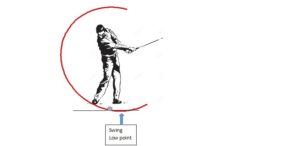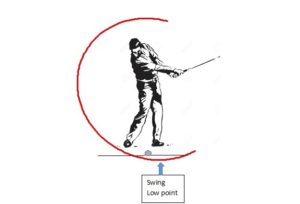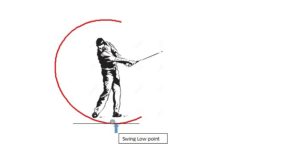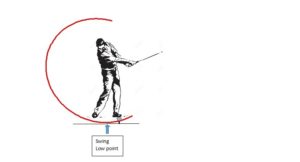Controlling your Low Point
Although golfers will have undoubtedly suffered from a lack of form at some point in their golf games this article is not about the mental highs and lows we experience. It is about putting our attention on the lowest point in our swing arc. Having a better feel and understanding of how you control this will allow you to have high quality strikes with both Irons and metals whilst maximising distance with your driver.
If you looked at a golf swing face on, the downswing makes a circular movement and although it is not perfectly circular or flawlessly planar (in plane) it is still similar to a hula hoop shape that we can start to think in terms of the lowest point in this circle relative to the ball and the ground.
To create those nice crisp strikes with an Iron off closely mown fairways the low point of the arc first of all must be in front of the ball as illustrated below
However you can catch the ball heavy (turf first) if your swing arc is too low and yet still have the low point in front of the ball. So it is not just about controlling the low point relative to the ball, the height of the arc relative to the ground must also be controlled.
When playing off a slightly fluffy lie and the ball is sat up, with hybrids or fairway metals, you can get good results when the low point is only just in front of the ball and not too deep. This gives a nice sweeping action that only bruises the grass rather than takes a big divot. If the low point and arc are too low here it tends to lead to skied shots or shots caught high on the face.
With driver and in general terms, the ideal way to help you maximise length is to catch the ball after the low point (on a slight up swing). This is a good reason to play the ball forward in the stance.
The next time you get a chance take some practice swings notice where your natural swing hits the ground. Then see what it feels like to move this surface contact both from forward to back in relation to your stance and also catching the turf deeply aa well as just bruising the top of the surface. This will make you aware of the feel you need to have when playing different shots on the course.
One other note, in my experience there is often a relationship (albeit not directly) with swing path to low point and arc control. I often find that those swings that are very dominantly in-to-out relative to target line will tend to get the low point before the ball. Those with an exaggerated out-to-in path have a low point after the ball but will be deep. Check your divot direction when taking these practice swings and try to get them pointing along your target line.
Paul Thompson has been the Fellow PGA Professional at Powerscourt Golf Club in Wicklow since 1995. In addition to providing coaching on-site he also is a coach with The Golfing Union of Ireland. Appointments with Paul can be booked via Powerscourt Golf Club Reception: Tel (01) 204 6033 or the Golf Shop Tel (01) 204 6031. Read more about lessons from Paul Thompson by visiting the Powerscourt Golf Club Website.






